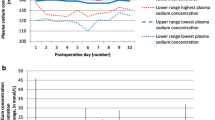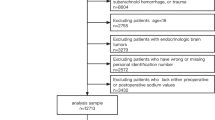Abstract
Introduction
Disturbances in plasma sodium levels are a major complication following recent resections of craniopharyngiomas in children. They must be properly managed to avoid neurological sequelae. We aimed to describe the variations and characteristics of postoperative natremia in children who had undergone a first craniopharyngioma resection with a particular focus on the frequency of triphasic syndrome in these patients.
Methods
Paediatric patients with craniopharyngiomas who underwent a first surgical resection in the neurosurgery department of the Hôpital Femme Mère Enfant (Lyon, France) between January 2010 and September 2021 were included in the present study and the medical records were analysed retrospectively.
Results
A total of 26 patients were included. Of these, 17 (65.4%) had a postoperative course characterised by the occurrence of both initial diabetes insipidus (DI) and hyponatremia a few days later. Eight patients (30.8%) presented then with isolated and persistent DI. Patients with the triphasic syndrome had a significantly higher grade of Puget classification on MRI (1 and 2), compared to the other patients.
Conclusion
Dysnatremia is common after craniopharyngioma resections in children. This immediate postoperative complication is particularly difficult to manage and requires rapid diagnosis and prompt initiation of medical treatment to minimize fluctuations in sodium levels and avoid neurological sequelae.
Similar content being viewed by others
Data availability
No datasets were generated or analysed during the current study.
References
Müller HL, Merchant TE, Warmuth-Metz M, Martinez-Barbera JP, Puget S, Craniopharyngioma (2019) Nat Rev Dis Primers 5(1):75
Rosemberg S, Fujiwara D (2005) Epidemiology of pediatric tumors of the nervous system according to the WHO 2000 classification: a report of 1,195 cases from a single institution. Childs Nerv Syst 21(11):940–944
Hoffmann A, Boekhoff S, Gebhardt U, Sterkenburg A, Daubenbüchel AM, Eveslage M et al (2015) History before diagnosis in childhood craniopharyngioma: associations with initial presentation and long-term prognosis. Eur J Endocrinol 173(6):853–862
Larijani B, Bastanhagh MH, Pajouhi M, Kargar Shadab F, Vasigh A, Aghakhani S (2004) Presentation and outcome of 93 cases of craniopharyngioma. Eur J Cancer Care (Engl) 13(1):11–15
A C AR, C AC, Ml G (2006) Neuroimaging of pediatric craniopharyngiomas: a pictorial essay. J Pediatr Endocrinol Metab 19(Suppl 1):299–319
Drapeau A, Walz PC, Eide JG, Rugino AJ, Shaikhouni A, Mohyeldin A et al (2019) Pediatric craniopharyngioma. Childs Nerv Syst 35(11):2133–2145
Puget S, Garnett M, Wray A, Grill J, Habrand JL, Bodaert N et al (2007) Pediatric craniopharyngiomas: classification and treatment according to the degree of hypothalamic involvement. J Neurosurg 106(1 Suppl):3–12
Ciurea AV, Saceleanu V, Mohan A, Moreanu MS, Toader C (2020) Craniopharyngiomas in children - experience of consecutive 152 operated cases. Acta Endocrinol (Buchar) 16(1):103–109
Hannon MJ, Thompson CJ (2019) Hyponatremia in neurosurgical patients. Front Horm Res 52:143–160
Smith D, Finucane F, Phillips J, Baylis PH, Finucane J, Tormey W et al (2004) Abnormal regulation of thirst and vasopressin secretion following surgery for craniopharyngioma. Clin Endocrinol (Oxf) 61(2):273–279
Edate S, Albanese A (2015) Management of electrolyte and fluid disorders after brain surgery for pituitary/suprasellar tumours. Horm Res Paediatr 83(5):293–301
Water balance disorders after neurosurgery the triphasic response revisited - PubMed [Internet]. 2010 Feb;3(1):42-44. https://doi.org/10.1093/ndtplus/sfp117. Epub 2009 Aug 29. [cited 2022 May 17]. https://pubmed.ncbi.nlm.nih.gov/20090880/
Finken MJJ, Zwaveling-Soonawala N, Walenkamp MJE, Vulsma T, van Trotsenburg ASP, Rotteveel J (2011) Frequent occurrence of the triphasic response (diabetes insipidus/hyponatremia/diabetes insipidus) after surgery for craniopharyngioma in childhood. HRP 76(1):22–26
Du C, Leng Y, Zhou Q, Xiao JX, Yuan XR, Yuan J (2022) Relationship between postoperative hypothalamic injury and water and sodium disturbance in patients with craniopharyngioma: a retrospective study of 178 cases. Front Endocrinol (Lausanne) 13:958295
Pratheesh R, Swallow DMA, Rajaratnam S, Jacob KS, Chacko G, Joseph M et al (2013) Incidence, predictors and early post-operative course of diabetes insipidus in paediatric craniopharygioma: a comparison with adults. Childs Nerv Syst 29(6):941–949
AFPA Association Française de Pédiatrie Ambulatoire [Internet]. Courbes AFPA- CRESS/Inserm -CompuGroup Medical 2018 non libres de droit [cited 2023 Jun 16]. Nouvelles courbes de croissance des filles françaises - AFPA. https://afpa.org/outil/courbes-de-croissance-filles-francaises/
Ohmori K, Collins J, Fukushima T (2007) Craniopharyngiomas in children. Pediatr Neurosurg 43(4):265–278
Taylor M, Couto-Silva AC, Adan L, Trivin C, Sainte-Rose C, Zerah M et al (2012) Hypothalamic-pituitary lesions in pediatric patients: endocrine symptoms often precede neuro-ophthalmic presenting symptoms. J Pediatr 161(5):855–863
Christ-Crain M, Winzeler B, Refardt J (2021) Diagnosis and management of diabetes insipidus for the internist: an update. J Intern Med 290(1):73–87
Gürbüz F, Taştan M, Turan İ, Yüksel B (2019) Efficiency of single dose of tolvaptan treatment during the triphasic episode after surgery for craniopharyngioma. J Clin Res Pediatr Endocrinol 11(2):202–206
Kruis RWJ, Schouten-van Meeteren AYN, Finken MJJ, Oostdijk W, van Trotsenburg ASP, Boot AM et al (2018) Management and consequences of postoperative fluctuations in plasma sodium concentration after pediatric brain tumor surgery in the sellar region: a national cohort analysis. Pituitary 21(4):384–392
Liu JK, Sevak IA, Carmel PW, Eloy JA (2016) Microscopic versus endoscopic approaches for craniopharyngiomas: choosing the optimal surgical corridor for maximizing extent of resection and complication avoidance using a personalized, tailored approach. Neurosurg Focus 41(6):E5
Paja M, Lucas T, García-Uría J, Salamé F, Barceló B, Estrada J (1995) Hypothalamic-pituitary dysfunction in patients with craniopharyngioma. Clin Endocrinol (Oxf) 42(5):467–473
Burke WT, Cote DJ, Penn DL, Iuliano S, McMillen K, Laws ER (2020) Diabetes insipidus after endoscopic transsphenoidal surgery. Neurosurgery 87(5):949–955
Author information
Authors and Affiliations
Contributions
L.B., C.M. and C.V. were involved in the conception, design and conduct of the study and the analysis and interpretation of the results. L.B. wrote the first draft of the manuscript. K.P. was involved in the interpretation of the results and reviewed the early version of the manuscript. S.C. carried out the MRI proofreading. All authors contributed to discussion and reviewed the final version of the manuscript.
Corresponding author
Ethics declarations
Ethics approval and consent to participate
Approval was obtained from the ethics committee of Lyon Children Hospital of the hospital (CSE-HCL – IRB 00013204; No 21_641). In line with national legislation, parents of children have been informed of this retrospective study by mail and could refuse to participate.
Competing interests
The authors declare no competing interests.
Additional information
Publisher’s Note
Springer Nature remains neutral with regard to jurisdictional claims in published maps and institutional affiliations.
Rights and permissions
Springer Nature or its licensor (e.g. a society or other partner) holds exclusive rights to this article under a publishing agreement with the author(s) or other rightsholder(s); author self-archiving of the accepted manuscript version of this article is solely governed by the terms of such publishing agreement and applicable law.
About this article
Cite this article
Bazus, L., Perge, K., Cabet, S. et al. Evaluation of postoperative fluctuations in plasma sodium concentration and triphasic response after pediatric craniopharyngioma resection: A French cohort study. Childs Nerv Syst (2024). https://doi.org/10.1007/s00381-024-06451-3
Received:
Accepted:
Published:
DOI: https://doi.org/10.1007/s00381-024-06451-3




